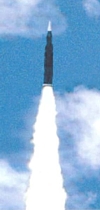China Test-Launches New Ballistic Missile

China has test launched a DF-31 long-range ballistic missile, according to a report by the Russian news agency ITAR-TASS. The missile was said to have been launched from the Wuzhai launch site on Monday night.
The DF-31 has been under development since the 1980s and Monday’s flight test appears to be the sixth flight test of the missile since 1999. The U.S. Department of Defense predicted in 2002 that the DF-31 would be deployed “before mid-decade,” but that didn’t happen. The current DOD prediction is that deployment may happen this year. Some web sites erroneously say the missile is already operational.
The DF-31 forms the core of China’s current modernization of long-range nuclear ballistic missiles. Two modifications of the DF-31 are under development. The road-mobile DF-31A has a longer range (possibly up to 12,000 km), and the 8,000+ km range Julang-2 is intended to arm China’s next generation of ballistic missile submarines (Jin-class).
There is considerable confusion and uncertainty about the capability of the DF-31. Early reports predicted a range of at least 8,000 km (4,875 miles), but the latest DOD estimate is 7,250+ km (4,500+ miles). China has not yet tested the DF-31 to the full range reported by the DOD. Tuesday’s test launch impacted in the Takla Makan Desert some 2,500 km west of Wuzhai. If the range is 7,250+, the DF-31 will not be able to target the entire continental United States, only the most northwestern parts. Its main role may be against Russia, India, as well as U.S. facilities in the Pacific including Hawaii and Guam.
Another confusion concerns the payload. Despite widespread speculation among private analysts and media that the new missiles will carry multiple warheads, the U.S. intelligence community anticipates that all three missile types will carry a single warhead each.
Later this month (September), FAS and the Natural Resources Defense Council will publish a joint report about Chinese nuclear forces and U.S. nuclear targeting of China. The report uses high-resolution satellite images and declassified documents to describe the nuclear relationship between China and the United States.
See also: Elusive Chinese Submarine Cave Spotted | Nuclear Notebook on Chinese Nuclear Forces
While it is reasonable for governments to keep the most sensitive aspects of nuclear policies secret, the rights of their citizens to have access to general knowledge about these issues is equally valid so they may know about the consequences to themselves and their country.
Nearly one year after the Pentagon certified the Sentinel intercontinental ballistic missile program to continue after it incurred critical cost and schedule overruns, the new nuclear missile could once again be in trouble.
“The era of reductions in the number of nuclear weapons in the world, which had lasted since the end of the cold war, is coming to an end”
Without information, without factual information, you can’t act. You can’t relate to the world you live in. And so it’s super important for us to be able to monitor what’s happening around the world, analyze the material, and translate it into something that different audiences can understand.